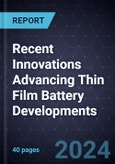The Flexibility, Lightness, and Safety of Thin Film Batteries Attract Global Interest
Electronic devices are an integral part of human life, serving a multitude of functionalities. Many application areas - for example, electronic gadgets, health monitoring and medical devices, activity tracking, smart cards, and wearable electronics - require lightweight, flexible, and compact energy storage solutions. The focus on miniaturization and compactness in electronic devices has catalyzed the need for said solutions. Thin film batteries address the critical needs of the industry by providing reliable, lightweight, compact, and portable energy storage that enables self-powering devices.
Thin film Batteries are electrochemical energy storage devices typically fabricated by layer deposition of active battery material and are differentiated by their compact and flexible form factor as opposed to conventional cylindrical, or prismatic batteries. These batteries typically utilize a non-aqueous, polymer-based electrolyte that also functions as a separator by electronically disconnecting both electrodes - the cathode and the anode. As a result, thin film batteries do not require an additional separator material. Additionally, the non-aqueous electrolyte allows the battery to be flexible and conform to various shapes as the geometry of the application area necessitates, leading to much better space utilization.
This report analyzes the various types of thin film batteries classified based on rechargeability as well as battery architecture and contains the following topics. Additionally, it examines the technology landscape of thin film batteries and their classification according to their working mechanism. This section also expands on the typical material used in the fabrication of thin film battery components including the cathode, anode, electrolyte, and current collector. The study highlights key application areas.
Additionally, the report examines the innovation landscape for thin film batteries - highlighting key commercial players involved in the sector and analyzing the patent landscape for thin film batteries for the past 3 years. Finally, the study provides a growth opportunity analysis: it determines the key growth enablers and restraints for the thin film battery industry. Finally, it identifies three specific growth opportunities for stakeholders to leverage in the coming years.
Table of Contents
Companies Mentioned (Partial List)
A selection of companies mentioned in this report includes, but is not limited to:
- Molex
- STMicroelectronics








